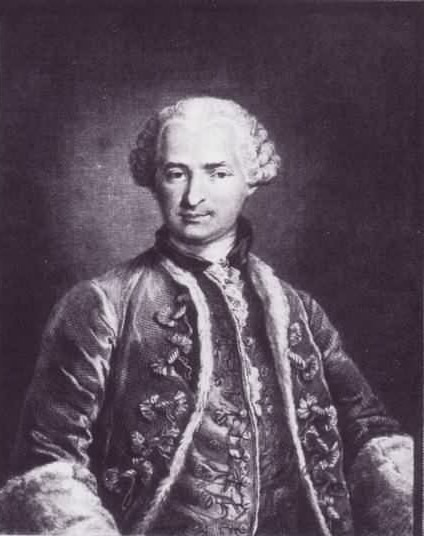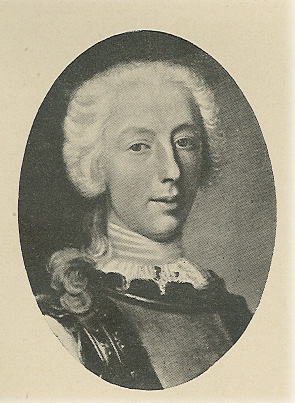On this Eleventh Day of Myth-mas, Si Spurrier gives to us the Compte de Saint Germain, a man who became more myth than person by his own doing.

Click links for previous Days of Myth-mas:
On the First Day of Myth-mas, Si Spurrier gave to us… THE ZOMBIE.
On the Second Day of Myth-mas, Si Spurrier gave to us … THE HORRIFYING PENANGGALAN.
On the Third Day of Myth-mas, Si Spurrier gave to us … THE SLEIPNIR.
On the Fourth Day of Myth-mas, Si Spurrier gave to us … THE LITTLE PEOPLE.
On the Fifth Day of Myth-mas, Si Spurrier gave to us … THE YARA-MA-YHA-WHO.
On the Sixth Day of Myth-mas, Si Spurrier gave to us … THE BLACK HOUND.
On the Seventh Day of Myth-mas, Si Spurrier gave to us … THE ANGELS OF MONS.
On the Eighth Day of Myth-mas, Si Spurrier gave to us … THE KAPPA.
On the Ninth Day of Myth-mas, Si Spurrier gave to us … OTTAR THE SIMPLE.
On the Tenth Day of Myth-mas, Si Spurrier gave to us … THE UNICORN.
—
Many myths and folktales have monsters, beasts and morals, constructed to explain the world. Today, on the Eleventh Day of Myth-mas, Si Spurrier explores the Compte de Saint Germain, who became more myth than man as a result of his own storytelling.
By SI SPURRIER
A very nifty example now of how myths can grow (like excitingly-coloured fungus) not just upon ancient and poorly remembered things, nor only upon the credulity and gossip of those who hear wild stories, but upon any living person willing to blur their own reality.
The Compte de Saint Germain was indubitably a real man who lived during the 18th century. Given his flamboyance, seeming wealth and polymathic skills he was probably the well educated son of someone very important. He claimed in later life that his father was Prince Francis II Rákóczi of Transylvania, which would sort of fit with what we know of him, except that the dates of his birth are all wrong, his first language seemed to be Spanish and, oh yeah, he was a compulsive liar.
The Count pops up amongst the dizziest circles of European aristocracy throughout the 1700s, notably in London, where he hobnobbed with Horace Walpole and casually tossed-off a few operatic arias before being arrested as a spy during the Jacobite revolution; then in Paris, where he entertained Giacomo Casanova and Madame de Pompadour, winning the favour of the King and building the bored monarch a personalised chemistry lab; then in Holland, where he meddled in the backroom politics of the Seven Years’ War and was – again – arrested as a spy; and then in Schleswig (in modern-day Denmark) where he joined the Prince in all manner of occultish secret societies and alchemical experiments. He spoke at least five languages, wrote scads of celebrated music, contributed materially to the chemical sciences and the production of coloured dyes, conducted innumerable covert shenanigans on behalf of aristocratic belligerents all over Europe, owned a fabulous library of occult works and quite probably wrote a bunch of them himself.
This, to conclude, was one hell of a guy.
But, yes: also a big fucking liar. For much of his life he refused to say who he truly was or where he came from, or simply presented a multitude of different origin stories and identities to fill the gap. He seems to’ve worn his reputation for outrageous quackery with some pride: one of those people (we all know one) who’s so good at faking his way through a conversation with zero expertise that listeners grudgingly accept his testimony through force of will alone. An impressive bullshit artist, basically. He claimed to be fabulously long-lived, impossibly wealthy, scandalously well sexed and mystically empowered. So well known was his penchant for tall tales and self-aggrandisement that at least one infamous imposter pretended to be him, adding fuel to the fire of the Count’s own outrageous claims. Researching him, one quickly reaches the point that – even within his own lifetime – one can’t say precisely where the rumours that surrounded him originated: from him or from his celebrants. But rumours there indeed were: that he was over three hundred years old, that he could melt diamonds, that he knew the alchemical secret of the Universal Elixir, and so on. One senses this was a man who saw little practical difference between his fabulously impressive real life exploits and those that were fabricated.
This is gonzo Mythology at its best.

In 1972, Richard Chanfray claimed to be the Count, and purportedly turned lead into gold to prove it.
The Count probably died in 1784, though a good myth won’t let a paltry thing like that get in its way. Thanks in no small part to his real-life interest in mysticism, his posthumous memory was joyously appropriated in the late 1800s by celebrated nutfucks (and/or charlatans, depending on your point view) Madame Blavatsky and Annie Besant, leaders of the exponentially spreading Theosophy Movement. Much given to halfassed psychic twaddle and interventions from spirit-guides, both women claimed to’ve met him – yes, he was still alive a hundred years later – and re-branded him as an immortal Ascended Master and the Rosicrucian Herald of the Violet Age, who had for centuries been mistaken as that other mythical immortal, Ahaseurus the Wandering Jew. There are still more than a few New Age types out there who continue to regard the Compte de Saint Germain as a Really Real supernatural entity and glorious mahatma of the coming utopia.
I can’t help thinking the old goat was grinning when they buried him.
—
NEXT: THE ENCANTADO.



June 16, 2016
you got it wrong, so very wrong.
December 25, 2017
I found of my researching trip unknown details of Richard Chanfray…
very intresting items..